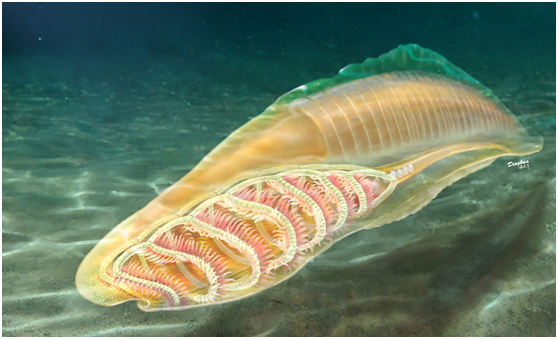[Scientific research progress] The discovery of cell cartilage confirmed that Yunnan worm was the most primitive vertebrate before 5 billion years ago
Author:Chinese Academy of Sciences So Time:2022.07.08
Recently, Chinese scientists have found that the Yunnan worm produced by the Cambrian of the Cambrian of 518 million in the Cambrian Ji Chengjiang Animal Group has the unique cell cartilage structure of vertebrates, and confirmed that Yunnan worms are the most primitive group of vertebrates. The achievement was completed by the "Early Early Evolution of Life System" research team led by Researcher Zhu Maoyan, a researcher at the Nanjing Institute of Geological Palace of the Chinese Academy of Sciences, and the research team of Professor Jiang Baoyu of the School of Earth Sciences and Engineering of Nanjing University, and published it on July 8, 2022 In the American "Science" journal. Researcher Zhao Fangchen of the Nanjing Poto Institute and Professor Jiang Baoyu of Jiang Baoyu served as the author of the results of the results. Tian Qingzheng, a doctoral student under the co -guidance of the two, was the first author, and the team Zeng Zeng was the third author.

Yunnan worm ecological restoration map (directed by Zhao Fangchen, Yang Dinghua drawing)
In the process of life evolution, the evolution of vertebrates, the score of human beings, is one of the most magnificent chapters. The problem of the origin of vertebrates is always the most attractive scientific hotspot. Evolutionary biologists usually speculate that the ancestors of vertebrates are a type of rear animal with spine, dorsal neurotrants and gill fissures based on the characteristics of the characteristics of the existing head cable. However, this false vertebrate ancestor has never been supported by fossil evidence.
The Burgis shale animal group, Canada, about 505 million years ago and the Chengjiang Animal Group, Yunnan, China, which is about 518 million years ago, has a wealth of animal fossils characterized by soft body structures. Among them, the Bolgis shale animal groups that have been discovered in 1909 produced the head cabled animal pickup fish (PIKAIA) and Metaspriggina (Metaspriggina). MYLLOKUNMINGIA (Myllokunmingia) and the doubtful Yunnanozoon (Yunnanozoon), including Yunnanozoon. These fossils are the oldest spine animals in the world so far, providing precious materials for the mysteries of the origin and early evolution of vertebrates.

Yunnan insect specimen, 3.9 cm long (Zhao Fangchen's picture)
Different from Kunming fish with typical vertebrate characteristics, Yunnan worm form is closer to the head of the head of the head of the head. It has always been controversial on the location of the vertebrate and the rear animal system tree. Researcher Chen Junyuan and others of Nanjing Paleozoic Institute of Paleozoic creatures used Yunnan worms as the earliest ridge animals in 1995 in the "Nature" magazine, the New York Times and Science Weekly "" from Yunnan worms to you "and" leading to the backbone bone " The road was given a special review. After that, Chen Junyuan and others discovered a large number of new Yunnan worm specimens in the Haikou area of Kunming. Based on the more fine anatomical structures on these specimens, they attributed Yunnan worms as the original head, thinking that its evolution position was between the head cablewood Wenchang fish and vertebrates. After this achievement was published in the "Nature" magazine in 1999, a major discussion on the classification of Yunnan insects was set off in the academic community. Due to the large differences in the interpretation of different scholars' explanation of the details of the software tissue preserved in Yunnan worms, the Yunnan worm has been classified as vertebrate, head cable animals, semi -cable animals, rear animal dry groups, and dry groups of animal organizations in 1991. Even the original symmetrical animals.

Comparison of Yunnan insect evolution positions and various ridge animal throat shapes (from top to bottom, namely Wenchang fish, Yunnan worm, Hou Sprig fish, sedimental eel, shark) (A) evolved tree and throat morphological patterns distributed. (, Extinction group (B) side view (C) abdominal view. (Tian Qinghuan's drawing)
The controversy in the classification position of Yunnan insects seriously affects the restraint of such key fossils on the origin of vertebrates. In response to the mystery of Yunnan insect classification positions, in the case of conventional morphological research cannot reach consensus, this research team uses three -dimensional X -ray faults to scan microscope, Fourier infrared spectrum, Raman spectrum, scanning electron microscope, and transmitted electrical mirrors Modern experimental technical means, I hope to crack this mystery from micro anatomy.
Based on Chen Junyuan and his collaborators in 2003, the Yunnan worm gill bow may have an important clue of cell cartilage. The research team analyzed the gill bow structure of 127 Yunnan worm specimens produced in Haikou area. The Stacked Discoid Structure and Fibrillin Microfibril were found. The stacked cell structure is a unique arrangement of cartilage cells, while protein microman fiber is a fiber structure of vertebrate cartilage common cell matrix. These two features prove that Yunnan worms have a unique pharyngeal bow that is unique to vertebrates and composed of cell cartilage, indicating that Yunnan worms belong to the original vertebrate.
In order to further determine the specific evolution of the Yunnan worm, the research team has integrated the latest trait matrix, including rear animals and early vertebrate fossils, and increases the newly observed characteristic information of Yunnan worms. Reconstruction calculation. The analysis results confirmed that the Yunnan worm is in the most foundation of the vertebrate spectrum, between tails and other vertebrates (including existing and fossil species).

Yunnan wormworm fossil pharyngeal structure (A) overall photo of the pharynx; (B -E) micro -structure of pharynx arow: optical photo of the pharynx bow: (B) structural schematic diagram (C) a three -dimensional X -ray CT rendering of a single pharynx (D) ) Scanning electron microscopy photos of carbon residues in the throat, showing the protein micro -original fibrous fibrous fiber morphological structure of fossils (E) (Tian Qingyi's drawing) For the first pair of swallow bows that were controversial in Yunnan worms, the research team was on the new specimen on the new specimen. It is equivalent to the first pair of swallow bow positions, which are found in the same structure, gill filaments, and protein microbee fibers of the same gill bow. Therefore, Yunnan worms have 7 pairs of swallow bows with similar to each other and have cell cartilage. Similar swallow bows also appeared on another type of Cambrian Condroma -Hou Spirge Fish. The discovery of the 7 -pair of throat of the Yunnan insects supports the anatomy as early as the 19th century. The prototype of the bow, the jaw bow and the tongue bow of the vertebrate and the gill bow behind are the series of homologous structures. In other words, although the pharyngeal bows in different positions of the existing vertebrates will develop into different skeletons such as jaw arch, tongue bow and gill bow, but the pharyngeal bow in different positions in the early stage of the vertebrate evolution is similar to each other.
Another important new discovery of this research is that the 7 pairs of swallow bows of Yunnan worms are connected to the horizontal cartilage at the end of the abdomen. A set of bone slices around the road play a role in supporting and protecting. The throat of existing vertebrates is composed of mandibular bows, tongue arch, and gill bow bones). Basic pharynx is a typical feature of existing jaw -free vertebrate and fossil -free mandibular fish (Euphanerops). Separate cartilage sticks separated from each other. The throat characteristics of Sprig fish after the Sprig fish caused controversy about vertebrate ancestral throat shape. Earlier, the characteristic of Yunnan worm pharyngeal cranial in the foundation of vertebrates, supporting the more ancient ancestral characteristics.
It can be seen that, as the oldest close relatives of existing vertebrates, Yunnan worms provide key evidence to reveal the origin and early evolution of vertebrates, and the exploration of the evolution of vertebrate jaw and other key features will have a profound impact. From another perspective, the research once again shows the potential of the Chengjiang animal group fossils with the preservation of fine -scale biological structures.
The reviewer commented on this study: "This is a major contribution to science, and it will become a key paper in ancient vertebrate zoology. Cambrian Candy Spine vertebrate dispute. The information they show is a milestone. In the future many years, even higher resolution research is difficult to surpass. " The limit, this is a milestone work. "
The achievement was strongly supported by funds such as the Strategic Pioneer of the Chinese Academy of Sciences (Class B), the National Natural Science Foundation of China, the National Key Laboratory of Modern Paramissions and Stylology. Thank you Mr. Chen Junyuan for his encouragement and help for this research.
◎ Thesis related information:
Qingyi Tian, fangchen zhao*, Han Zeng, Maoyan zhu, baoyu jiang*, 2022. Ultrastruction revers angrate phasewangngangngang in yunnanozoans. Science, 377.
https://www.science.org/doi/10.1126/science.abm2708.
Copywriting | Zhao Fangchen (Nanjing Institute of Geological Paradise, Nanjing Academy of Sciences)
Capture Edit | Liu Yun
Copywriting review | Chen Xiaogen
- END -
Hangzhou's first batch of provincial technological innovation centers unveiled the completion o

Zhejiang News Client reporter Zhang Li produced Yan Dong correspondent Liu MengxiO...
Lintong District: Sweetly peach picking activities of "Science and Technology E -commerce Agricultural Agriculture"

Recently, the launching ceremony of the Science and Technology Promotion of Farmin...